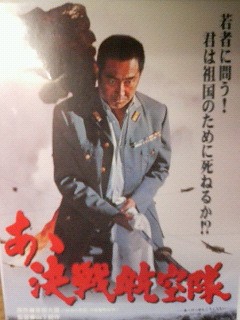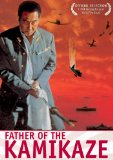| Reviews & Columns |
|
Reviews DVD TV on DVD Blu-ray 4K UHD International DVDs In Theaters Reviews by Studio Video Games Features Collector Series DVDs Easter Egg Database Interviews DVD Talk Radio Feature Articles Columns Anime Talk DVD Savant Horror DVDs The M.O.D. Squad Art House HD Talk Silent DVD
|
DVD Talk Forum |
|
|
| Resources |
|
DVD Price Search Customer Service #'s RCE Info Links |
|
Columns
|
|
|
Father of the Kamikaze
In a sense, Toei had picked up the banner previously held by rival Toho Studios, which thanks to special effects master Eiji Tsuburaya had held a firm grip on the genre with such films as Storm Over the Pacific (1960) and Battle of the Japan Sea (1969). Moreover, Toho also had director Kihachi Okamoto under contract and his films, including the superb war drama Japan's Longest Day (aka The Emperor and a General) eschewed such elaborate miniatures altogether.
But in the economic retrenchment (and following Tsuburaya's death), Toho had abandoned its yearly output of big scale war movies after 1971 or so, and Toei saw an opening. Though Toho would continue producing big-scale war epics every so often (such as 1981's Imperial Navy), Toei would dominate the genre for the next decade.
Father of the Kamikaze was, apparently, only marginally successful. It earned ¥338 million in rentals, tied for ninth among the year's top domestic films, but well behind Toho's Submersion of Japan and Prophecies of Nostradamus, which had rentals of ¥1.64 billion and ¥883 million, respectively. Even Toei's modest Female Convict Scorpion #701 - Grudge Song earned nearly ¥100 more at the box office. The DVD of Father of the Kamikaze runs a butt-breaking 197 minutes without an intermission. Sources aren't entirely clear, but this ultra-long edition seems to have had an extremely limited release in Japan, and that for its general release the film ran a more manageable 163 minutes.
Koji Tsuruta, best known in the west as Kojiro Sasaki in Hiroshi Inagaki's Musashi Miyamoto trilogy, stars as real-life Vice Admiral Takijiro Onishi, regarded as the architect of the kamikaze strategy of suicide bombers. As with most big Japanese war epics like this, its protagonist opposes war with America because he knows Japan can't possibly defeat a country with such unlimited natural resources and industrial might. But, being a loyal Japanese, once the order is given Onishi commits to the war effort 110%.
The conflicted emotions of these characters are virtually always the same in these films. Toshiro Mifune had a second career parallel to his samurai characters playing the similarly conflicted Admiral Isoroku Yamamoto, and slight variations of such characters in Shue Matsubayashi's Storm Over the Pacific/I Bombed Pearl Harbor (1960), Attack Squadron! (1963) and Okamoto's Japan's Longest Day (1967), which this film emulates in its last-half.
Toei, being a more politically conservative company than Toho, tries to have it both ways, with Father of the Kamikaze being more overtly nationalistic. Where Okamoto's war movies tend to be darkly cynical, and Matsubayashi, a former Navy officer, generally pays tribute to individual acts of bravery and self-sacrifice while condemning Japanese militarism overall, Toei's film suggests maybe it would have been better if Japan had fought to the last man after all.
It's hard to say for sure if the filmmakers merely want their audience to watch from a distance, awestruck by Onishi's near-religious devotion to the spirits of the men he sent to their deaths, or if they intended to go one step further, to rally Japan's younger generation into a more-enlightened sense of national pride. Then again, another answer is possible. Bunta Sugawara (The Man Who Stole the Sun), as Captain Kozo Yasuna of the Atsugi Air Corps, is depicted as an absolute fanatic convinced the Japanese Emperor was tricked into surrendering. (Upon hearing the Emperor's famous radio address, he barks "Don't listen to that shit!" which must surely have elicited a few gasps from shocked Japanese audiences.) From a 21st century westerner's perspective, Sugawara's character comes off as a complete nut, but who knows? Perhaps in the filmmakers' eyes, he is a patriot to the bitter end.
Most of the film, certainly, depicts a highly romanticized account of the war. One undeniably effective scene has a kamikaze pilot (pop singer Hideki Saijo) saying goodbye to his mother as he releases a firefly into the night to deliver his message. It's a film where Japanese women are all traditional and unhesitatingly self-sacrificing (when Onishi returns home to find the charred remains of his house, his wife dutifully reports, "It burned down very nicely."), where shady yakuza characters put country ahead of personal gain and get behind the war effort, where ordinary citizens have the good taste to starve to death off-screen. In this sense, the film is the antithesis of something like Kabei - Our Mother. The film is intermittently graphically violent; in one scene a pilot, reduced to pulp when his Zero crashes, is peeled off his plane's engine block, with little left but his flight suit.
The all-star cast is impressive, and includes Hiroki Matsukata, Ryo Ikebe, Toshio Kurosawa (very briefly), Tsunehiko Watase, and virtually every other male Toei actor on the lot. Fumi Dan appears as Watase's fiancée.
Despite its relatively high cost, it doesn't look like more than four or five full-size Zero replicas were built, and those might have been left over from the production of Tora! Tora! Tora!, which had likewise been filmed at the Toei-Kyoto Studios. Most of the film resorts to grainy wartime stock footage for its battle scenes, some of it in color, some in black and white. For some sequences, director Kosaku Yamashita opts to make the new footage grainy to match the stock shots. Tatsuo Honda is credited as special effects director of the limited but imaginative miniature and optical effects, some of which may have been culled from earlier movies.
Video & Audio
AnimEigo's presentation of Father of the Kamikaze is just about flawless. The 16:9 enhanced transfer preserves the 2.25:1 Toeiscope/Fujicolor lensing and the mono audio is crisp and clear. This long version of the film does not have an overture, exit music, or even an intermission break, which is surprising given its extreme length.
Probably responding to complaints from consumers about their use of multi-colored subtitles, viewers are given no less than six options here: (mostly) yellow or plain white subtitles, dialogue-only or full subtitles enhanced by annotations. The film can also be viewed with just the captions, or with no subtitles at all.
The opening titles scroll along at a fast clip so a complete set of translated titles have been moved in this case to a Notes section among the special features.
Extra Features
Included are two 16:9 trailers, along with a smattering of black & white and color publicity stills and a poster in a gallery section, an interactive map, as well as notes putting the film into historical context.
Parting Thoughts
Though star Koji Tsuruta delivers a fine performance as an emotionally conflicted man dedicated to the spirits of men he's condemned to death for a hopeless cause, Father of the Kamikaze otherwise follows the standard line of such films, and though frequently interesting, its excessive running time also works against it. Still, for those with an interest in Japanese films and the Pacific War, it's Recommended.
Film historian Stuart Galbraith IV's latest book, The Toho Studios Story, is on sale now.
|
| Popular Reviews |
| Sponsored Links |
|
|
| Sponsored Links |
|
|
| Release List | Reviews | Shop | Newsletter | Forum | DVD Giveaways | Blu-Ray | Advertise |
|
Copyright 2024 DVDTalk.com All Rights Reserved. Legal Info, Privacy Policy, Terms of Use,
Manage Preferences,
Your Privacy Choices | |||||||
















